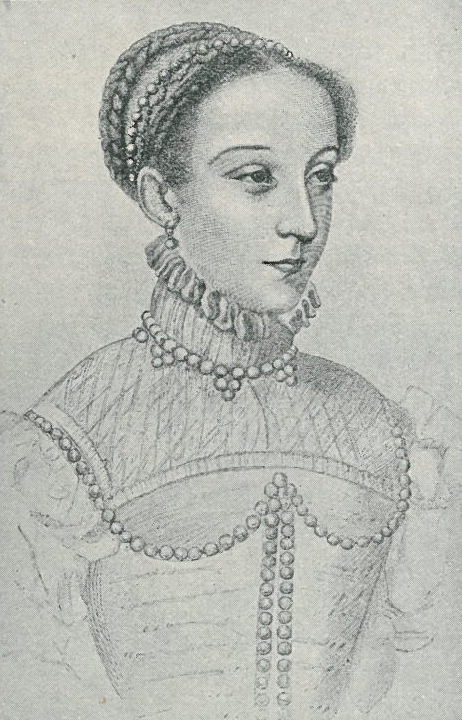This summer has seen the 450th anniversary of the royal progress of the twenty-year-old Mary Queen of Scots through the west of Scotland in 1563, passing through Stirlingshire, Glasgow, Dunbartonshire, Argyllshire, Ayrshire, Wigtownshire, Kirkcudbrightshire, Dumfriesshire, and then back to Edinburgh via Peebles.

The only surviving record of this journey is the list of stabling expenses kept by Mary’s French equerry, who noted down where she and her attendants spent each day and night, and the costs of lodging and feeding their eighteen horses and six baggage mules. The lords and gentlemen of the districts she was passing through, with their retainers, would have taken turns at accompanying her as an escort.
Having toured Argyllshire, the queen crossed the Firth of Clyde from Dunoon to the Ayrshire coast on 31 July, and stayed that night at Lord Sempill’s castle of Southannan near Fairlie. The next night, 1 August, she was the guest of Hugh Montgomerie, 3rd Earl of Eglinton, at Eglinton Castle. Having dined there on 2 August, she passed through the town of Irvine and travelled on down the coast to Ayr, where she spent the nights of 3 and 4 August. The provost and magistrates of the Royal Burgh of Ayr would have greeted the queen and her entourage as they passed over the Auld Brig and entered the town. The burgh records for this period have not survived, but it was customary for gifts of wine and confectionary to be presented on such occasions.
The stabling accounts, written in French, refer to the queen’s stay at ‘St Jehan d’Era’. Some historians have taken this to mean that she stayed at the town’s parish church of St John, but in fact it simply means ‘St John’s Town of Ayr’, John the Baptist being the town’s patron saint.

One of Queen Mary’s staunchest supporters was Sir Matthew Campbell of Loudoun. As Sheriff of Ayr, he was responsible for enforcing the queen’s laws and decrees within the county, this office being hereditary in his family. His seat was Loudoun Castle near Galston, but he had a fine town house in Ayr, purchased by his father from a wealthy merchant family, the Taits, and known ever since as Loudoun Hall. Although we have no record of where the queen spent her two nights in Ayr, Sir Matthew would certainly have accompanied her during her progress through the county, and the likelihood is that he would have had the honour of lodging her in his own house – many of her attendants probably had to hire accommodation elsewhere in the town.


Having no doubt spent 3 August holding audiences at which the gentlemen of the district and their ladies would have been presented to her, the queen left Ayr next day and continued her journey south. She spent the nights of 4, 5 and 6 August at Dunure Castle on the Carrick coast, as a guest of Gilbert Kennedy, 4th Earl of Cassillis, a young man only a little older than herself. The earl’s numerous Kennedy kin, who dominated this part of Ayrshire, would have visited to pay their respects, but the opportunities for riding out to hunt with hawks on the nearby hillsides would not have been neglected.

Mary finally left Dunure on 7 August, and spent that night at Ardmillan Castle just south of Girvan. Her host John Kennedy of Ardmillan was the cousin of Thomas Kennedy of Bargany. Thomas’s own castle of Ardstinchar at Ballantrae was the queen’s lodging on the night of 8 August, and the following day she passed out of Ayrshire, never to return, and continued on through Wigtownshire.

Five turbulent years later, Mary’s opponents defeated her supporters at the Battle of Langside, and she was forced to flee Scotland and begin the exile in England which would end with her execution in 1587. Among her adherents who were captured at the battle were Sir Matthew Campbell of Loudoun and the Earl of Cassillis – both eventually came to terms with the new regime. Sir James Fergusson of Kilkerran, in his chapter on the queen’s 1563 visit to Ayrshire in The White Hind (1963), referred to the many letters which she wrote to the earl from her English prisons, and concluded by remarking that, as she signed them, Mary must often have thought of happier times, and of ‘a good horse, and a fresh salt wind, and the sun on the sea, and the fair castle of Dunure’.

Good precis of MQOS ‘state of the nation’ tour through Ayrshire. Can anyone point me to source for detsails of her route onwards to Glen Luce?
Hi Drew,
The best source is the article ‘Tour of Mary, Queen of Scots, through South-western Scotland’, by Sir Herbert Maxwell, in The Scottish Historical Review, vol.18, 1921, pages 1-13. It has an annotated transcript of Mary’s equerry’s expenses roll for the progress through Ayrshire and Galloway.